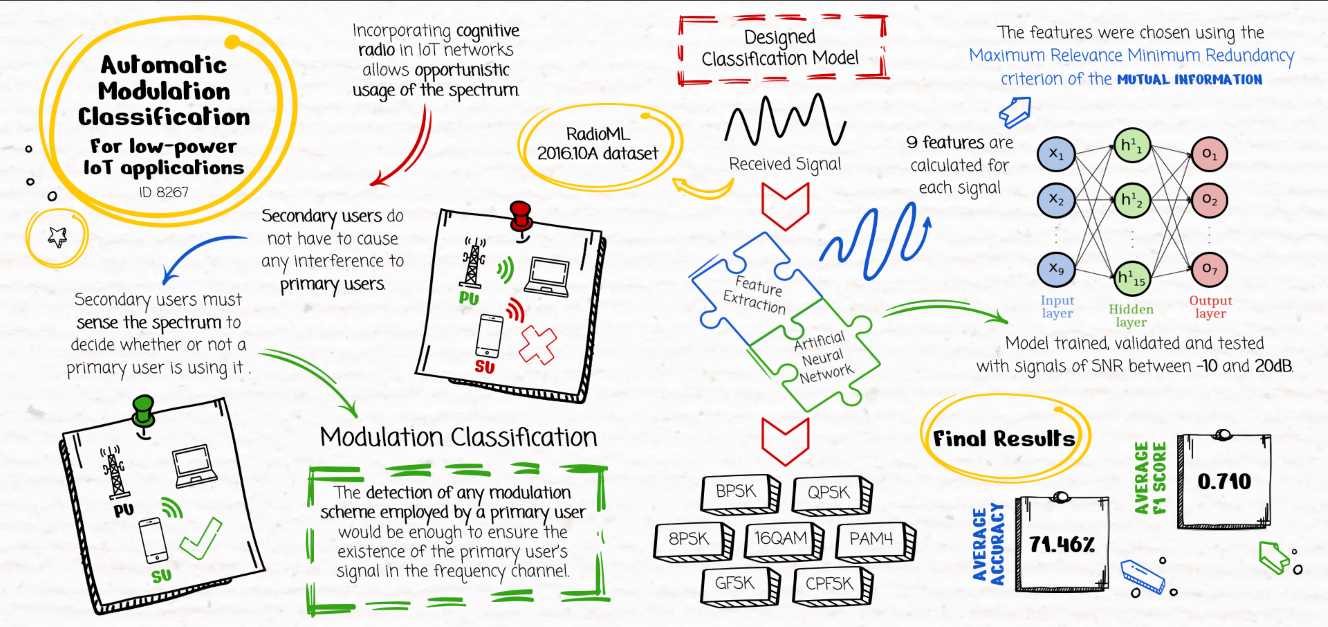Automatic Modulation Classification for low-power IoT applications
Keywords:
Internet of things, Radio spectrum access, Automatic modulation classification, Feature extraction, Mutual information, Artificial neural networkAbstract
The Internet of Things (IoT) has swiftly become one of the most important technologies in recent years. Radio spectrum access represents a stern challenge for the IoT as a consequence of the increased use of connected devices. This is particularly true for IoT devices operating in the unlicensed band where the huge demand for wireless connectivity will require techniques that use the spectrum efficiently. Avoiding training sequences enables a more efficient spectrum usage and has the additional advantage of reducing the power consumption of IoT devices, but it requires modulation identification mechanisms. This paper presents a simple yet efficient method to classify received signals according to their modulation type. We propose the application of a single hidden layer neural network with a small number of trainable parameters for performing the classification between seven different modulation types. The designed classifier achieves a maximum accuracy of 95% when the signal-to-noise ratio (SNR) of the input data is 12 dB, and in the presence of multi-path fading, sample rate offset and carrier frequency offset.
Downloads
References
S. Hanna, C. Dick, and D. Cabric, “Signal processing-based deep learning for blind symbol decoding and modulation classification,” IEEE Journal on Selected Areas in Communications, vol. 40, no. 1, pp. 82–96, 2022.
B. Dong, Y. Liu, G. Gui, X. Fu, H. Dong, B. Adebisi, H. Gacanin, and H. Sari, “A lightweight decentralized-learning-based automatic modulation classification method for resource-constrained edge devices,” IEEE Internet of Things Journal, vol. 9, no. 24, pp. 24 708–24 720, 2022.
M. Abdel-Moneim, W. El-Shafai, N. Abdel-Salam, E.-S. El-Rabaie, and F. Abd El-Samie, “A survey of traditional and advanced automatic modulation classification techniques, challenges and some novel trends,” International Journal of Communication Systems, 05 2021.
T. Huynh-The, Q.-V. Pham, T.-V. Nguyen, T. T. Nguyen, R. Ruby, M. Zeng, and D.-S. Kim, “Automatic modulation classification: A deep architecture survey,” IEEE Access, vol. 9, pp. 142 950–142 971, 2021.
C. Roy, S. S. Yadav, V. Pal, M. Singh, S. K. Patra, G. Sinha et al., “An ensemble deep learning model for automatic modulation classification in 5g and beyond iot networks,” Computational Intelligence and Neuroscience, vol. 2021, 2021.
S. Ramjee, S. Ju, D. Yang, X. Liu, A. E. Gamal, and Y. C. Eldar, “Fast deep learning for automatic modulation classification,” 2019.
D. Hong, Z. Zhang, and X. Xu, “Automatic modulation classification using recurrent neural networks,” in 2017 3rd IEEE International Conference on Computer and Communications (ICCC), 2017, pp. 695–700.
M. Usman and J.-A. Lee, “Amc-iot: Automatic modulation classification using efficient convolutional neural networks for low powered iot devices,” in 2020 International Conference on Information and Communication Technology Convergence (ICTC). IEEE, 2020, pp. 288–293.
T. J. O’Shea, J. Corgan, and T. C. Clancy, “Convolutional radio modulation recognition networks,” 2016.
M. Z. Nisar, M. S. Ibrahim, M. Usman, and J.-A. Lee, “A lightweight deep learning model for automatic modulation classification using residual learning and squeeze–excitation blocks,” Applied Sciences, vol. 13, no. 8, 2023. [Online]. Available: https://www.mdpi.com/2076-3417/13/8/5145
A. Hazza, M. Shoaib, S. A. Alshebeili, and A. Fahad, “An overview of feature-based methods for digital modulation classification,” in 2013 1st International Conference on Communications, Signal Processing, and their Applications (ICCSPA), 2013, pp. 1–6.
J. J. Popoola and R. van Olst, “Effect of training algorithms on performance of a developed automatic modulation classification using artificial neural network,” in 2013 Africon, 2013, pp. 1–6.
A. Alarbi and O. Alkishriwo, “Modulation classification based on statistical features and artificial neural network,” 05 2021, pp. 748–751.
M. M. Roganovic, A. M. Neskovic, and N. J. Neskovic, “Application of artificial neural networks in classification of digital modulations for software defined radio,” in IEEE EUROCON 2009, 2009, pp. 1700–1706.
J. Jagannath, N. Polosky, D. O’Connor, L. N. Theagarajan, B. Sheaffer, S. Foulke, and P. K. Varshney, “Artificial neural network based automatic modulation classification over a software defined radio testbed,” in 2018 IEEE International Conference on Communications (ICC). IEEE, 2018, pp. 1–6.
Z. Kaleem, M. Ali, I. Ahmad, W. Khalid, A. Alkhayyat, and A. Jamalipour, “Artificial intelligence-driven real-time automatic
modulation classification scheme for next-generation cellular networks,” IEEE Access, vol. 9, pp. 155 584–155 597, 2021.
J. Lee, B. Kim, J. Kim, D. Yoon, and J. W. Choi, “Deep neural network-based blind modulation classification for fading channels,” in 2017 International Conference on Information and Communication Technology Convergence (ICTC), 2017, pp. 551–554.
Deepsig-Inc. Rf datasets for machine learning. [Online]. Available: https://www.deepsig.ai/datasets
G. Callebaut, G. Leenders, J. Van Mulders, G. Ottoy, L. De Strycker, and L. Van der Perre, “The art of designing remote iot devices—technologies and strategies for a long battery life,” Sensors, vol. 21, no. 3, 2021. [Online]. Available: https://www.mdpi.com/1424-8220/21/3/913
R. Holtzman, “Wideband frequency modulation applications and techniques.” Microwave Journal, vol. 58, 2015.
S. Bharadwaj and R. Sharma, “A comparative study of different amplitude modulation signals,” 07 2021.
H. L. Hirsch, “Statistical signal characterization-new help for real-time processing,” in Proceedings of the IEEE 1992 National Aerospace and Electronics Conference NAECON. IEEE, 1992, pp. 121–127.
N. B. Gallagher, “Savitzky-golay smoothing and differentiation filter,” Eigenvector Research Incorporated, 2020.
A. Abdelmutalab, K. Assaleh, and M. El-Tarhuni, “Automatic modulation classification based on high order cumulants and hierarchical polynomial classifiers,” Physical Communication, vol. 21, pp. 10–18, 2016.
H. Peng, F. Long, and C. Ding, “Feature selection based on
mutual information criteria of max-dependency, max-relevance, and min-redundancy,” IEEE Transactions on Pattern Analysis and Machine Intelligence, vol. 27, no. 8, pp. 1226–1238, 2005.
G. Panchal, A. Ganatra, Y. Kosta, and D. Panchal, “Behaviour analysis of multilayer perceptrons with multiple hidden neurons and hidden layers,” International Journal of Computer Theory and Engineering, vol. 3, no. 2, pp. 332–337, 2011.
P. Triantaris, E. Tsimbalo, W. H. Chin, and D. G¨und¨uz, “Automatic modulation classification in the presence of interference,” in 2019 European Conference on Networks and Communications (EuCNC). IEEE, 2019, pp. 549–553.


